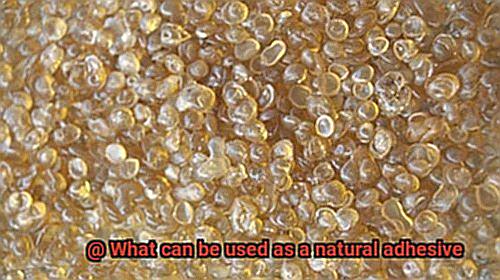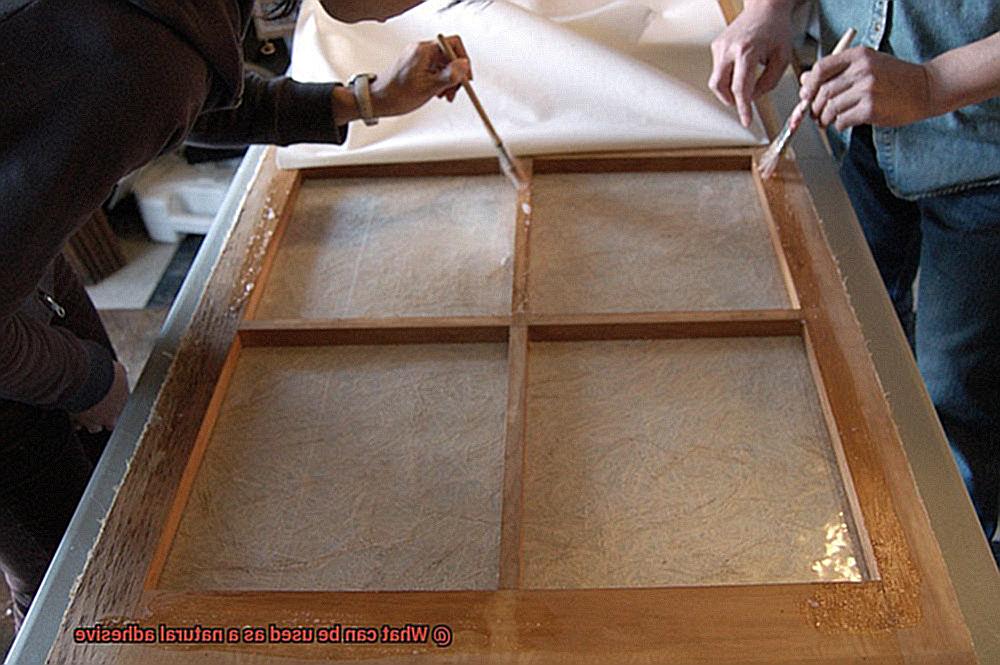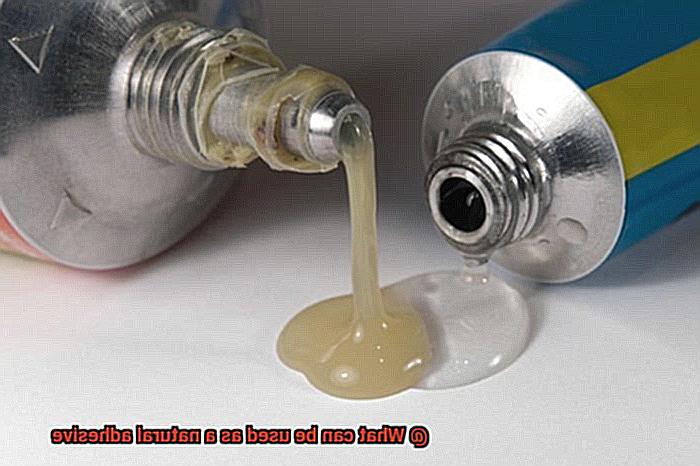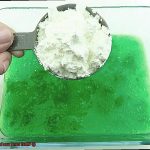When it comes to sticking things together, most of us automatically grab the regular glue from the store. But did you know that there are a bunch of natural materials that work just as well?
And not only are they good for the environment, but they also have some pretty cool benefits. From plant-based options like soy and starch to animal-derived choices such as casein and hide glue, the world of natural adhesives is seriously fascinating.
In this article, we’re going to dive into each of these materials and explore what makes them so special. We’ll talk about their characteristics, what they can be used for, and all the advantages they bring.
So whether you’re an artsy person looking for a natural solution or someone curious about sustainable alternatives in industries, keep reading because we’re about to uncover the wonders of natural adhesives.

Plant-based adhesives
Contents
In a world where sustainability and eco-consciousness are at the forefront, plant-based adhesives offer a refreshing alternative to traditional synthetic glues. Derived from various plant sources, these natural adhesives provide strong bonding capabilities while reducing environmental impact. Let’s dive into the fascinating world of plant-based adhesives and discover their applications across industries.
Natural Rubber Latex:
Derived from the sap of the rubber tree, natural rubber latex is a milky white liquid that possesses excellent adhesive properties. With its remarkable ability to bond different materials together, this adhesive has found widespread use in woodworking, paperboard production, and carpet manufacturing.
Picture craftsmen seamlessly joining pieces of wood or intricate patterns of carpet fibers locked in place by nature’s own glue.
Soy-Based Adhesives:
Soybeans contain natural proteins that can be extracted and processed into versatile adhesives. These adhesives have become increasingly popular in plywood, particleboard, and laminated wood products.
Imagine furniture made from sustainably sourced wood, held together by a soy-based adhesive that offers strong bonding capabilities without the harmful chemicals found in synthetic alternatives.
Starch-Based Adhesives:
Derived from plant sources such as corn, potato, or wheat, starch-based adhesives are biodegradable and renewable. Widely used in packaging, paper production, and bookbinding industries, these cost-effective adhesives offer reliable bonding while minimizing environmental impact. Envision beautifully bound books with pages seamlessly joined using a starch-based adhesive that respects both craftsmanship and Mother Nature.
Tannin-Based Adhesives:
Tannins are naturally occurring compounds found in various plants and possess unique adhesive properties. Used in woodworking, leather production, and even winemaking, tannin-based adhesives are both biodegradable and derived from renewable resources.
Imagine artisans delicately working with leather, using tannin-based adhesives to create masterpieces that are not only visually stunning but also environmentally friendly.
Lignin-Based Adhesives:
Lignin, a complex organic polymer found in plant cell walls, is a byproduct of the paper-making process. Researchers are exploring its potential in adhesive production for wood composites and fiberboard manufacturing.
Utilizing lignin can help reduce reliance on petroleum-based adhesives and contribute to a more sustainable future. Picture a world where furniture, cabinets, and flooring are made from wood composites bonded together by lignin-based adhesives, ensuring both strength and environmental responsibility.
Animal-based adhesives
In a world dominated by synthetic adhesives, it is easy to overlook the natural wonders that have stood the test of time. Animal-based adhesives, such as hide glue, fish glue, and casein glue, have been trusted for centuries and continue to find applications in diverse industries.
Join us as we delve into the captivating world of these remarkable adhesives and explore their historical significance and modern uses.
Hide Glue: A Timeless Bonding Agent
Derived from animal hides, tendons, and bones, hide glue has been a staple adhesive in woodworking, bookbinding, and musical instrument making. Its reversible nature allows for disassembly and repair without damaging the wood. Craftsmen have cherished hide glue for its ability to form strong bonds that withstand the test of time.
Fish Glue: The Flexible Artisan’s Choice
Made from collagen found in fish skins, bones, and swim bladders, fish glue offers exceptional adhesion properties. Renowned for its flexibility, fish glue is commonly used in paintbrush production, gilding, and restoration work. It provides a durable bond that can withstand the rigors of artistic endeavors.
Casein Glue: The Milk Protein Miracle
Derived from milk protein called casein, casein glue has been a preferred adhesive for woodworking, paperboard manufacturing, and paint pigment binding for centuries. Its robust bond and resistance to moisture make it a reliable choice in various industries. With its ease of preparation and ability to dry into a hard bond, casein glue continues to make its mark.
Applications:
- Woodworking Industry: Hide glue’s strength and reversibility allow for disassembly and repair without causing harm.
- Paintbrush Production: Fish glue’s flexibility ensures brush hairs maintain their integrity while providing durability.
- Paper and Packaging Industry: Casein glue effectively bonds cellulose-based materials used in paperboard manufacturing.
Sustainability and Considerations:
While animal-based adhesives have a rich history, it is crucial to consider their sustainability and ethical implications. Sourcing these adhesives may raise concerns about animal welfare and environmental impact. As a result, plant-based alternatives derived from starch or natural resins are gaining popularity as more sustainable options.
Natural resin adhesives
Step into the captivating world of natural resin adhesives, where ancient secrets meet modern-day craftsmanship. Derived from sticky substances secreted by plants like pine trees, these remarkable adhesives have been trusted by artisans across various industries for centuries.
Here, we will delve into the exceptional characteristics, wide-ranging applications, historical significance, and eco-friendly nature of natural resin adhesives.
Characteristics:
Derived from renewable plant sources, natural resin adhesives offer a sustainable alternative to synthetic options. These adhesives are extracted through tapping or heat extraction methods, resulting in a versatile adhesive with unique properties.
When heated, they soften into a pliable state, allowing for easy application. However, upon cooling, they harden with tenacity, creating strong and durable bonds between different materials.
Their resistance to moisture and chemicals makes them suitable for both indoor and outdoor applications.
Applications:
Embark on a journey through the diverse applications of natural resin adhesives. In woodworking and furniture making, shellac takes center stage. Derived from the secretions of the lac insect found in Southeast Asia, this natural resin adhesive provides impeccable bonding strength and a beautiful finish.
The music industry also relies on natural resin adhesives; rosin, obtained from pine tree sap, is widely used to provide grip on violin bows.
Beyond these industries, natural resin adhesives find their way into bookbinding, musical instrument production, and even food-grade applications.
Historical Significance:

Let history come alive as we uncover the rich historical significance of natural resin adhesives. From ancient Egyptian coffins to Renaissance-era furniture, these adhesives have played a vital role in preserving art and craftsmanship throughout time.
The use of shellac as an adhesive can be traced back centuries, highlighting its enduring trustworthiness and effectiveness.
Eco-Friendly Nature:
Marvel at the eco-friendly nature of natural resin adhesives, derived from renewable plant sources. Unlike their synthetic counterparts, these adhesives are biodegradable and do not release harmful chemicals into the environment.
The historical significance of natural resin adhesives adds to their appeal, as they have been trusted for centuries without causing harm to the planet. Embrace the ancient secrets of natural resin adhesives and contribute to a more sustainable future.
Milk-based adhesives
Discover the enchanting world of milk-based adhesives: the natural, non-toxic, and eco-friendly glue that will revolutionize your crafting experience.
Imagine a glue that not only bonds materials together but also cares for your health and the environment. It may sound like a dream, but milk-based adhesives are here to make it a reality.
Let’s dive into the captivating properties and applications of these incredible adhesives. First and foremost, one of their standout features is their non-toxicity.
Unlike synthetic glues that can contain harmful chemicals, milk-based adhesives are safe to handle and won’t release any toxic fumes during application.
Breathe easy knowing that you’re not exposing yourself or your loved ones to hazardous substances.
But don’t be fooled by their non-toxic nature – milk-based adhesives are also renowned for their bonding strength. They create powerful bonds with a variety of materials, from wood and paper to fabric and leather. Whether you’re working on a woodworking project or repairing bookbindings, milk-based adhesive has got your back.
What sets milk-based adhesives apart from their synthetic counterparts is their biodegradability. While synthetic glues can linger in the environment for years, milk-based adhesives break down naturally over time without causing harm to Mother Earth. Say goodbye to guilt and hello to eco-friendly crafting.
These incredible adhesives have a rich history too. Ancient craftsmen used casein glues derived from milk for woodworking, bookbinding, and even as an ingredient in paint. Today, they are still used in industries such as woodworking, paper packaging, and conservation/restoration. By choosing milk-based adhesives, you’re not only embracing a traditional craft but also joining a long line of artisans who appreciate the value of natural materials.
However, it’s important to note that milk-based adhesives have their limitations. They are sensitive to moisture and may weaken or lose their adhesive properties when exposed to water or high humidity. So while they’re perfect for indoor applications, it’s best to avoid using them outdoors or in damp environments.
Using milk-based adhesives is a breeze. Simply mix the powdered casein with water to create a paste, apply it to the surfaces you want to bond, and let it dry. The drying time may vary depending on the thickness of the adhesive layer and environmental conditions.
Natural latex adhesives
Step into the extraordinary world of natural latex adhesives, where eco-friendliness meets unparalleled bonding prowess. If you yearn for environmentally conscious alternatives to traditional adhesives, prepare to be captivated.
In this article, we will unravel the remarkable characteristics, advantages, and applications of natural latex adhesives, illuminating their enchanting bonding properties and limitless versatility.
So, sit back, savor a cup of tea, and embark on a journey into the realm of nature’s adhesive magic.
Eco-Friendliness:
At the heart of natural latex adhesives lies their eco-friendly essence. Derived from the sap of rubber trees, these adhesives utilize a renewable resource that leaves only a minuscule environmental footprint.
Unlike synthetic counterparts that often harbor harmful chemicals, natural latex adhesives are biodegradable, breaking down naturally over time without causing harm to the environment. By embracing natural latex adhesives, you take a small but significant step towards reducing your carbon footprint.
Bonding Properties:
When it comes to bonding, natural latex adhesives perform their enchantment. They offer exceptional bonding strength and flexibility, making them ideal for a vast array of applications.
Whether you are crafting woodwork masterpieces, constructing furniture with precision, or packaging delicate items with care, natural latex adhesives ensure reliable and enduring bonds.
Their resilience against heat, moisture, and chemicals ensures that your creations endure the test of time.
Versatility:
From wood to paper, fabric to foam, and even certain plastics—natural latex adhesives possess the power to fuse diverse materials seamlessly. This peerless versatility renders them indispensable across various industries where different materials must harmoniously coalesce. Whether you are an ardent DIY enthusiast or a seasoned craftsman, natural latex adhesives unlock boundless possibilities for your creative endeavors.
Availability:
Obtaining natural latex adhesives is a breeze. They are available in various forms—liquid latex, latex paste, or pre-made adhesive products—satisfying every adhesive need. Hardware stores, home improvement centers, and online marketplaces offer an extensive selection, ensuring swift access to your eco-friendly adhesive journey. With just a few clicks or a quick trip to the store, you can embark on your quest for nature’s glue.
Vegetable oil-based adhesives
These natural adhesives, derived from plant oils like soybean, linseed, and castor oil, are gaining popularity as people increasingly seek sustainable solutions for their bonding needs. Let’s delve into the enchanting characteristics, advantages, and applications of these remarkable adhesives that leave only a minuscule environmental footprint.
The first captivating aspect of vegetable oil-based adhesives is their eco-friendly nature. Unlike traditional synthetic adhesives, they are non-toxic, biodegradable, and renewable. Bid farewell to harmful chemicals and embrace a greener future. With low VOC emissions, you can breathe easy knowing you’re not releasing harmful pollutants into the air.

Soybean oil takes center stage as one of the most commonly used vegetable oils for adhesives. Its adhesive properties are outstanding, and it can be easily modified to suit different applications. Linseed oil impresses with its strong bonding prowess, making it a popular choice in woodworking projects. And let’s not forget castor oil – known for its incredible adhesive strength and excellent water resistance – perfect for those tough jobs that demand durability.
The applications of vegetable oil-based adhesives are as vast as your imagination. From woodworking masterpieces to paper packaging and bookbinding, these adhesives offer a versatile solution for various bonding requirements. Formulated with different viscosities and curing times, they ensure a seamless bond every time.
But what about substrates? Fear not. Vegetable oil-based adhesives are compatible with a wide range of materials including wood, paper, cardboard, and even some plastics. Whether you’re crafting a wooden masterpiece or creating an innovative paper sculpture, these adhesives have got you covered.
To unlock the full potential of vegetable oil-based adhesives, additives such as resins, waxes, or fillers can be incorporated. These additives enhance their performance, ensuring a reliable bond that withstands even the harshest conditions.
While these natural adhesives offer countless benefits, it’s important to note that they may not be suitable for high-stress applications and may have slower curing times compared to synthetic adhesives. Nevertheless, their eco-friendly nature and compatibility with various substrates make them an excellent choice for most bonding needs.
Bio-based adhesives
In a world increasingly focused on sustainability and eco-friendliness, bio-based adhesives have emerged as a game-changer. Derived from renewable resources like plants and animals, these adhesives offer a greener alternative to their synthetic counterparts. Let’s dive deeper into the world of bio-based adhesives, exploring their various types and advantages over traditional adhesives.
Types of Bio-Based Adhesives:
Starch-Based Adhesives:
Derived from starch extracted from plants like corn and potatoes, these adhesives find applications in the paper and packaging industries. They offer exceptional bonding strength and can be easily modified to meet specific requirements.
Soy-Based Adhesives:
Made from soy protein, a byproduct of soybean oil extraction, soy-based adhesives are widely used in woodworking, construction, and automotive industries. They boast excellent bonding properties, low toxicity, and lower VOC emissions.
Lignin-Based Adhesives:
Lignin, a complex polymer found in plant cell walls, is commonly used as an adhesive in wood composites and fiberboard production. It offers good water resistance and can serve as a sustainable alternative to formaldehyde-based adhesives.
Natural Rubber Adhesives:
Derived from the latex sap of rubber trees, natural rubber adhesives are known for their high tackiness and flexibility. They find applications in tapes, labels, and flooring materials due to their excellent adhesion to various surfaces.
Advantages of Bio-Based Adhesives:
Sustainability:
Bio-based adhesives are derived from renewable resources, reducing our dependence on fossil fuels. This makes them a sustainable choice for industries aiming to reduce their environmental impact.
Reduced Toxicity:
Unlike synthetic adhesives that often contain harmful chemicals, bio-based adhesives have lower toxicity levels. This ensures a safer working environment for employees and reduces health risks.
Lower VOC Emissions:
Volatile Organic Compounds (VOCs) released by synthetic adhesives can contribute to air pollution and respiratory issues. Bio-based adhesives, with their lower VOC emissions, help improve indoor air quality and reduce environmental harm.
Biodegradability:
Bio-based adhesives are often biodegradable, meaning they can break down naturally over time without leaving harmful residues. This contributes to a cleaner environment and reduces waste accumulation.
Traditional methods of making natural adhesives
In an era marked by an unwavering commitment to sustainability and eco-conscious alternatives, the beauty of traditional methods for crafting natural adhesives has resurfaced.
Passed down through generations, these age-old techniques harness the power of nature, employing ingredients sourced from the earth to yield adhesives that are not only non-toxic and environmentally friendly but also deeply steeped in cultural significance.
Brace yourself for a profound exploration of the captivating realm of natural adhesives as we delve into the intricate techniques and enchanting ingredients behind their creation.
Animal Glue:
Among the most revered and time-honored natural adhesives lies animal glue, a true testament to craftsmanship’s evolution. This ancient adhesive owes its existence to the process of boiling animal hides, bones, or hooves to extract collagen—a sticky substance that solidifies upon cooling.
Resilient and versatile, animal glue is cherished in woodworking, bookbinding, and even in the meticulous artistry of crafting musical instruments.
Plant Resin Adhesives:
From the very heartbeat of trees and plants emanates plant resin—the cornerstone of countless traditional adhesives. Through tapping or resin collection, these resins are procured and then harmoniously blended with beeswax, oils, or ash to forge formidable and enduring adhesives.
Embracing multiple applications, plant resin adhesives find their place in woodworking, pottery creations, and even in ancient rituals such as mummification—an indelible thread connecting antiquity with modernity.
Milk-Based Adhesives:
A unique manifestation of nature’s ingenuity manifests itself in milk-based adhesives, with casein glue leading the way. Derived from milk protein, this captivating adhesive serves as a stalwart companion in woodworking and paper conservation alike.
Through the alchemical process of curdling milk and isolating the casein protein, this adhesive is meticulously blended with lime or other additives to yield a versatile bonding agent with extraordinary properties.
Starch-Based Adhesives:
Within the realm of rice or potato paste resides another captivating chapter of natural adhesives: starch-based wonders. These archaic yet ingenious adhesives have stood the test of time, finding their place in various crafts for centuries. The recipe is simple—a concoction of starch and water cooked to a thick paste-like consistency. These adhesives grace the world of paper crafts, collage work, and even serve as steadfast wallpaper adhesives.
Environmental benefits of natural adhesives
Today, we embark on an enchanting journey into the world of natural adhesives and discover their remarkable environmental benefits. From biodegradability to supporting sustainable practices, these eco-friendly wonders are revolutionizing the adhesive industry and paving the way for a more sustainable and greener future.
Biodegradability:
Step into the harmonious cycle of nature. Unlike their synthetic counterparts, natural adhesives possess the incredible power of biodegradability. Derived from renewable resources such as plants, animals, or microorganisms, these adhesives break down naturally over time, leaving no harmful residues behind. Mother Nature smiles at this seamless integration with the environment.
Lower Carbon Footprint:
Bid farewell to guilt-ridden adhesive choices. Natural adhesives boast a lower carbon footprint compared to their synthetic counterparts. With less energy-intensive production processes and minimal use of fossil fuels, these eco-friendly glues emit fewer greenhouse gases. It’s a sustainable choice that helps combat climate change while still getting the job done.
Reduced Toxicity:
Indoor air pollution? Not on our watch. Synthetic adhesives often release volatile organic compounds (VOCs), contributing to poor indoor air quality. Natural adhesives, however, derived from safe and non-toxic sources, are a breath of fresh air – literally. Feel confident knowing you’re making safer choices for your health and the environment as you bond materials together.
Supporting Sustainable Practices:
Join the green revolution. Natural adhesives lend their adhesive prowess to various industries. In construction, they can be used in wood composites or insulation boards, reducing reliance on synthetic alternatives that may leach toxic substances over time. Embrace sustainability by promoting practices that align with our planet’s needs.
Performance Advantages:
Who says eco-friendly can’t be effective? Studies have shown that natural adhesives derived from soy or cornstarch can exhibit comparable or even superior bonding properties compared to their synthetic counterparts. It’s a win-win situation for both the environment and performance-driven applications. Say goodbye to compromise and hello to eco-friendly excellence.
taBdsSFyJsY” >
Conclusion
The possibilities for natural adhesives are vast. From plant-based materials like tree sap and starch to animal-based substances such as bone glue and casein, nature offers a plethora of options. These adhesives have been used by ancient civilizations and continue to be utilized today for various purposes.
Tree sap, with its sticky consistency, has been employed as an adhesive for centuries. It can be collected from trees like pine or birch and used in its raw form or processed into resin. This natural adhesive is not only effective but also sustainable, making it an excellent choice for environmentally conscious individuals.
Starch, derived from sources like corn or potatoes, is another natural adhesive that has found its place in many industries. When heated with water, starch undergoes a chemical transformation, forming a thick gel-like substance that can bond materials together. Its versatility makes it suitable for applications ranging from paper products to textiles.
Animal-based adhesives offer unique properties that make them valuable in specific contexts. Bone glue, made from boiling animal bones and connective tissues, is known for its exceptional strength and durability. It has been used historically in woodworking and musical instrument construction due to its ability to withstand stress and vibrations.
Casein glue, derived from milk proteins, is another remarkable natural adhesive. It possesses excellent bonding properties and is commonly used in woodworking, bookbinding, and even the manufacturing of certain types of paint. Its versatility and reliable performance have made it a popular choice among craftsmen throughout history.
In conclusion, the world of natural adhesives is rich with options that cater to various needs. Whether you prefer plant-based alternatives like tree sap or starch or opt for animal-derived choices like bone glue or casein, there is no shortage of possibilities when it comes to finding a natural adhesive that suits your requirements.






